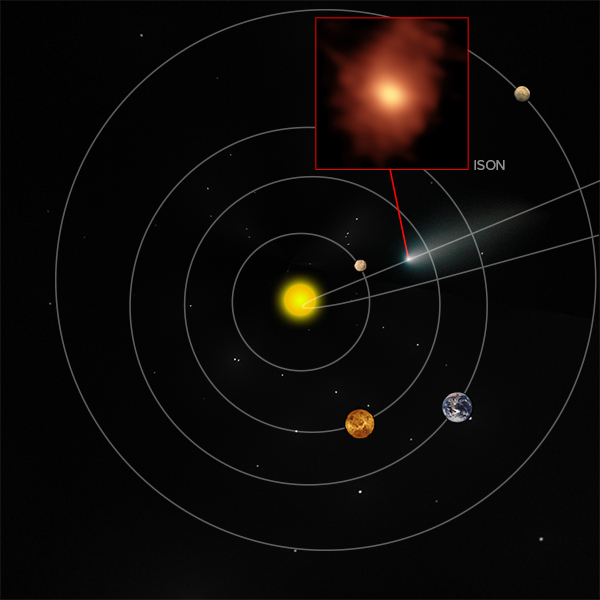Comets Forge Organic Molecules in Their Dusty Atmospheres, ALMA Confirms

Credit: B. Saxton (NRAO/AUI/NSF); NASA/ESA Hubble; M. Cordiner, NASA, et al. Approximate location of Comet ISON in our Solar System at the time of the ALMA observations.
Comets contain some of the oldest and most pristine materials in our Solar System. Understanding their unique chemistry could reveal much about the birth of our planet and the origin of organic compounds that are the building blocks of life. ALMA's high-resolution observations provided a tantalizing 3D perspective of the distribution of the molecules within these two cometary atmospheres, or comas.
“We achieved truly first-of-a-kind mapping of important molecules that help us understand the nature of comets,” said team leader Martin Cordiner, a Catholic University of America astrochemist working at NASA’s Goddard Space Flight Center in Greenbelt, Maryland.
The critical 3D component of the ALMA observations was made by combining high-resolution, two-dimensional images of the comets with high-resolution spectra obtained from three important organic molecules – hydrogen cyanide (HCN), hydrogen isocyanide (HNC), and formaldehyde (H2CO). These spectra were taken at every point in each image. They identified not only the molecules present but also their velocities, which provided the third dimension, indicating the depths of the cometary atmospheres.
The new results revealed that HCN gas flows outward from the nucleus quite evenly in all directions, whereas HNC is concentrated in clumps and jets. ALMA’s exquisite resolution could clearly resolve these clumps moving into different regions of the cometary comas on a day-to-day and even hour-to-hour basis. These distinctive patterns confirm that the HNC and H2CO molecules actually form within the coma and provide new evidence that HNC may be produced by the breakdown of large molecules or organic dust.
“Understanding organic dust is important, because such materials are more resistant to destruction during atmospheric entry, and some could have been delivered intact to the early Earth, thereby fueling the emergence of life,” said Michael Mumma, director of the Goddard Center for Astrobiology and a co-author on the study. “These observations open a new window on this poorly known component of cometary organics.”
“So, not only does ALMA let us identify individual molecules in the coma, it also gives us the ability to map their locations with great sensitivity,” said Anthony Remijan, an astronomer with the National Radio Astronomy Observatory (NRAO) in Charlottesville, Virginia, and a study co-author.
The observations, published today in the Astrophysical Journal Letters, were also significant because modest comets like Lemmon and ISON contain relatively low concentrations of these crucial molecules, making them difficult to probe in depth with Earth-based telescopes. The few comprehensive studies of this kind so far have been conducted on extremely bright comets, such as Hale-Bopp. The present results extend them to comets of only moderate brightness.
Comet ISON (formally known as C/2012 S1) was observed with ALMA on November 15-17, 2013, when it was only 75 million kilometers from the Sun (about half the distance of the Earth to the Sun). Comet Lemmon (formally known as C/2012 F6) was observed on June 1-2, 2013, when it was 224 million kilometers from the Sun (about 1.5 times the distance of the Earth to the Sun).
“The high sensitivity achieved in these studies paves the way for observations of perhaps hundreds of the dimmer or more distant comets,” said Goddard’s Stefanie Milam, a study co-author. “The findings suggest that it should also be possible to map more complex molecules that have so far eluded detection in comets.”
This research was funded by the NASA Astrobiology Institute through the Goddard Center for Astrobiology and by NASA’s Planetary Atmospheres and Planetary Astronomy programs.
The Atacama Large Millimeter/submillimeter Array (ALMA), an international astronomy facility, is a partnership of Europe, North America and East Asia in cooperation with the Republic of Chile. ALMA is funded in Europe by the European Southern Observatory (ESO), in North America by the U.S. National Science Foundation (NSF) in cooperation with the National Research Council of Canada (NRC) and the National Science Council of Taiwan (NSC) and in East Asia by the National Institutes of Natural Sciences (NINS) of Japan in cooperation with the Academia Sinica (AS) in Taiwan.
Contact Information
Charles Blue
cblue@nrao.edu
Phone: 434-296-0314
Mobile: 202-236-6324
Media Contact
More Information:
http://www.nrao.eduAll latest news from the category: Physics and Astronomy
This area deals with the fundamental laws and building blocks of nature and how they interact, the properties and the behavior of matter, and research into space and time and their structures.
innovations-report provides in-depth reports and articles on subjects such as astrophysics, laser technologies, nuclear, quantum, particle and solid-state physics, nanotechnologies, planetary research and findings (Mars, Venus) and developments related to the Hubble Telescope.
Newest articles

Superradiant atoms could push the boundaries of how precisely time can be measured
Superradiant atoms can help us measure time more precisely than ever. In a new study, researchers from the University of Copenhagen present a new method for measuring the time interval,…

Ion thermoelectric conversion devices for near room temperature
The electrode sheet of the thermoelectric device consists of ionic hydrogel, which is sandwiched between the electrodes to form, and the Prussian blue on the electrode undergoes a redox reaction…

Zap Energy achieves 37-million-degree temperatures in a compact device
New publication reports record electron temperatures for a small-scale, sheared-flow-stabilized Z-pinch fusion device. In the nine decades since humans first produced fusion reactions, only a few fusion technologies have demonstrated…





















